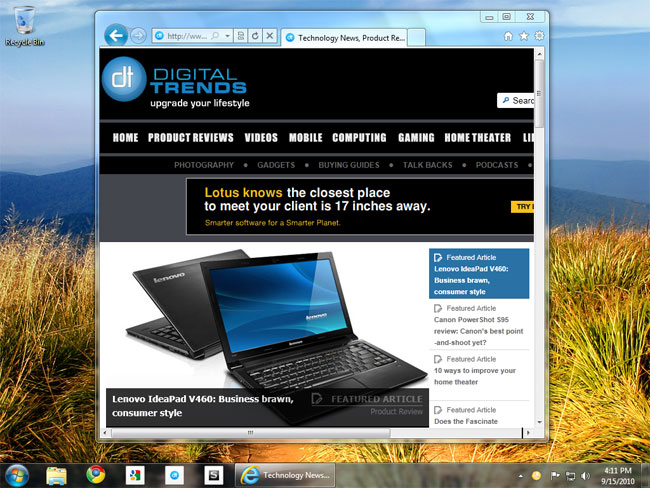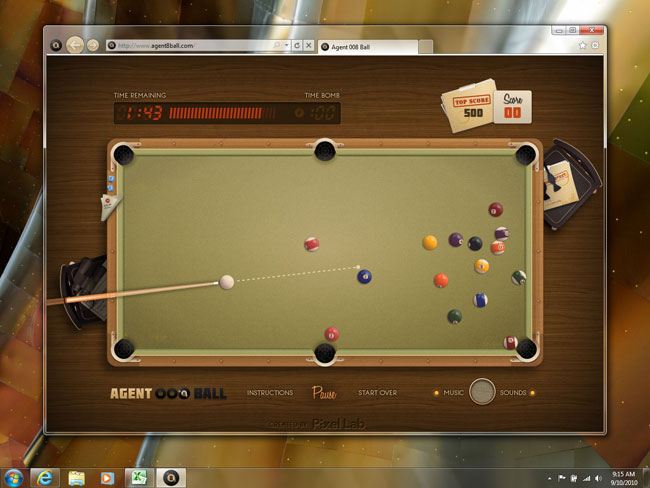
Internet Explorer 9 is lean, powerful, and fast, just like the new Microsoft. Could the new browser herald the age of a reborn Microsoft?
The browser wars were defined back in the day when Microsoft was the underdog. Back in the 90s, Microsoft was focused on AOL, consequently creating MSN to combat what was then thought to be the biggest threat to Microsoft’s dominance. Netscape came along and slapped Bill Gates, causing Microsoft to counter-punch Netscape into obsolescence with a free browser in the form of Internet Explorer. The last decade has been defined by Microsoft giving up share mostly to Firefox, the one successful offspring of Netscape’s Navigator, with this market share decline becoming one of the most visible examples of Microsoft not being able to compete in this space anymore.
This decade, and today, IE9 launched to applause, excitement, and a relatively large number of excited developers — all things we saw very little of ten years ago, and potentially a significant indicator that Microsoft could be yet again having a comeback.
Creating magic with IE9
IE9 isn’t about emphasizing Microsoft’s proprietary technology, but HTML5. At the IE9 launch, that meant wall-to-wall eye candy from a large variety of application developers and Web designers. Years ago, Microsoft CEO Steve Ballmer gave a famous (or some say infamous) speech to the Microsoft faithful, with his key point being that Microsoft’s future was tied tightly to developers. And since that time, Microsoft has seemed to forget this very core part of what had made it successful.

The floor at the IE9 launch was awash with developers who were not only showcasing compelling Web experiences, but singing the praises of Microsoft and IE9. From games like the pool game from Agent008, to media sites like my favorite BBC Top Gear site (I had been told that Top Gear had been cancelled and was pleased to find out that I was told wrong, new season starts in a couple of weeks), folks were showcasing how much faster and more consistent IE9 is from any other shipping or beta browser.

The two coolest demonstrations were from USA Today, which had initially been designed for the iPad and was easily converted over to work with IE9. It showcases how New Orleans has changed between the end of hurricane Katrina and now. A sliding bar shifts the picture as the bar crosses it, from the way it was to the way it is. In some cases things are vastly better, in others you see clear fields where buildings once stood, and are profoundly sad.

But the one that really makes the point is a fun site on the “Lost World’s Fairs” which showcases one of the most important improvements IE9 brings to Web developers — the ability to use a wide variety of fonts without having to Photoshop images of them. This alone could save days in the time it takes to create and update websites, and let designers focus more on the design of the site and less on the mechanics of creating it.
Performance Monitor
My personal favorite feature is the performance monitor. This feature looks at the add-ins you have installed and flags any that significantly slow down the browser. Like you, I’ve collected a lot of plug-ins and redundant task bars over the years, and had no idea how much they were slowing down my browser. With one click, I got rid of those that were killing the speed of my browser, including one old one from Microsoft itself, then IE9 jumped to warp speed.
Hardware Accelerated
IE9 is fully hardware accelerated, and this has Nvidia, AMD and surprisingly, Intel all dancing naked in the streets. OK, sorry for that mental image. So wipe that and think of something more visually acceptable at full frame rates, and making complete use of your graphics subsystem. This means if you pay extra for more powerful graphics, you get a vastly better browsing experience particularly for graphic-intensive sites. Now, typically Intel would have a coronary about this, but this week the company previewed its Sandy Bridge platform, which will show up next year; one developer at IDF (Intel’s Developer Conference) said it has astounding graphics performance. So Intel actually likes this as well, though its capability here doesn’t really get off the ground until next year, when Sandy Bridge comes to market.
Now both Chrome and Safari are partially hardware accelerated, but demonstration after demonstration showcased that Microsoft’s fully hardware accelerated browser was vastly faster. Granted, these were vendor-sourced demonstrations, but they were done in front of third-party developers and backed up the results.
To be clear, if you have Intel integrated graphics or a Mac (which no longer runs IE, or runs it under an emulator where hardware acceleration generally doesn’t work) you won’t see any real change. But if you have Nvidia or AMD graphics, you’ll get a significant speed boost for animation and graphic-intensive sites. Even for video sites you’ll get things like picture-in-a-picture working at full frame rates which you likely won’t see on another browser or if you don’t have a discrete graphics card.
A lot of bang for zero bucks
The nice thing about web browsers is that they are free, so it costs nothing to try them out or switch between them. That made it easy to switch away from IE, and it makes it just as easy to see if you want to switch back. Apple,Google, and Mozilla are not likely to leave Microsoft unchallenged, and the best thing about competition like this is that regardless of who is ahead, we win as long as we can get access to the product. This is a lot of technoogy for nothing, and I think it showcases that Microsoft is finally coming to the market ready to compete. In other words, this isn’t just a major change for the Web, but it, along with Windows 7, Xbox Kinect, and Windows Phone 7 is part of what may be a new, more competitive, Microsoft than we have seen in more than a decade. I can’t see that as a bad thing, because I’m getting pretty sick of Google’s arrogance and increasingly think that company needs a wakeup call like Microsoft got a while back. IE9 and Bing are just the beginning of that wakeup call.
No comments:
Post a Comment